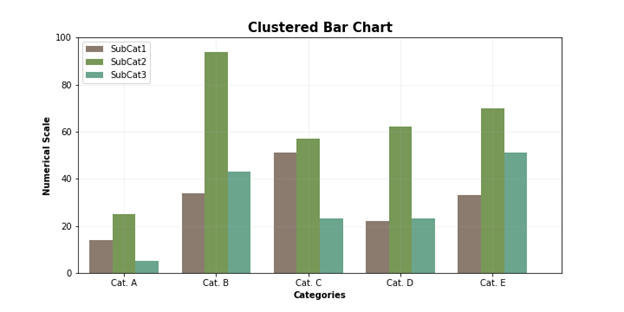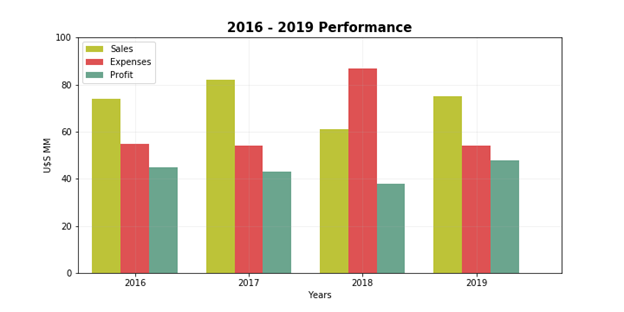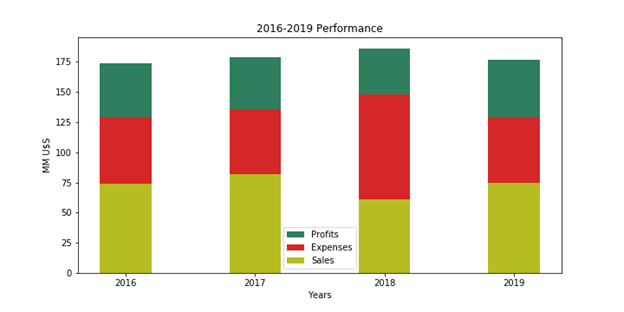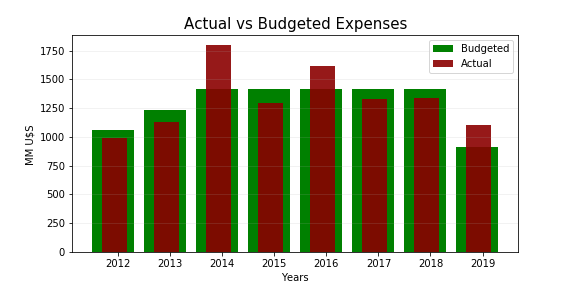How to Read the Standard Overlap Bar
Amassed & Overlapped Bar Charts
![]()
Why & How

1.- Clustered Bar Charts
AKA: grouped, side-by-side, multiset [bar charts, bar graphs, cavalcade charts]
Why: Clustered Bar Charts (CBC) brandish numerical information well-nigh the relative propo r tion that exists betwixt a main category and its subgroups that belongs to a second categorical variable. Similar to Stacked Bar Graphs, they should be used for Comparisons and Proportions but with emphasis on Limerick. Unlike Stacked Bar Graphs, the elements that make upwardly the subcategories may be diffusely related. CBC are particularly constructive when a whole is divided into multiple parts. They enable to make comparisons across subcategories whilst Stacked Bar Graphs make comparisons inside subcategories.
They permit to visualize how subgroups change over time, but the chart becomes difficult to read with the extension in fourth dimension and with the increase in the number of subcategories. They should not be used for Human relationship or Distribution analysis.
How: as usual with bar charts, CBC are ii-dimensional with ii axes: i centrality shows categories, the other axis shows numerical values. The axis where the categories are indicated does not accept a scale to highlight that it refers to discrete (mutually sectional) groups. The axis with numerical values must accept a calibration with its corresponding measurements units.
CBC are represented by means of sets of rectangular bars that can be oriented horizontally or vertically. Each principal category is divided into a cluster of bars representing subcategories of the second categorical variable. The quantity of each subcategory is shown by the length or height of those rectangular bars that are located adjacent forming a cluster, with gaps betwixt clusters slightly wider than a single standard bar.

Subcategories can be ordinal or nominal but equivalent subgroups must have the same color in each cluster and so as not to confuse the audience. It is essential to employ an appropriate color palette, a balanced spacing and a layout that facilitates comparison. Every bit bars are heavy visual markers, apply gridlines scantily only for improving the storytelling.
The following effigy shows information about a visitor operation related with sales, expenses and profits for the 2016–2019 period. Information technology is a vertically oriented clustered bar nautical chart with years as the main category. Sales, expenses and profit are yearly represented every bit a cluster. The visualization clearly highlights that in 2018, even with the increment in expenses and reduction in sales, profit remained relatively constant.

Information technology is interesting to compare the same data represented by ways of a stacked bar chart. As previously indicated, CBC are appropriate when you want to compare beyond subcategories: sales in 2016 versus 2017 vs. 2018 vs. 2019; expenses in 2016 versus 2017 vs. 2018 vs. 2019; profit in 2016 versus 2017 vs. 2018 vs. 2019. On the contrary, the stacked bar chart just enables to do a practiced comparison for the segments near the baseline (sales) because expenses and profits accept dissimilar initial baselines. As well, the superlative of each principal bar (sum of sales + expenses + profit of a particular yr) does not brand any sense.

Next figure is related with statistics of third education in the European Union (EU-28) in 2017. At that place were 19.8 million tertiary students that yr, women accounted for 54% of that number although the majority of the students following doctoral titles were men. Besides, a quarter of all students were involved in concern, administration and law studies. The following clustered bar chart shows that female surpasses male in Instruction, Social Sciences, Arts and Humanities, Health and Welfare and also in Business, Administration and Law studies. On the other hand, male surpasses female in It and Engineering, Manufacturing and Construction studies (Eurostat, 2020). The chart clearly displays numerical information nigh the participation of men and women in tertiary teaching across broad fields of education. It is a CBC horizontally oriented where educational fields make up the master category while gender is the second categorical variable.

The principal trouble with clustered bar graphs is that they don't conspicuously visualize the ratio of the individual parts relative to the whole. As a result, proportions are not piece of cake to evaluate. Their strength is related with direct comparisons between equivalent subcategories of the second categorical variable.
2.- Overlapped Bar Charts
AKA: Overlay, Overlapping, Superimposed [bar charts, bar graphs, cavalcade charts]
Why: Overlapped Bar Charts (OVC) are used to brand comparisons between different items or categories. OVC compare only two numerical variables per item or category in a unmarried diagram. The numerical variables must exist closely related to merit a comparison. They are also used to prove trends over time based on like bounds. They should non be used for Relationship or Distribution analysis.
The conceptual thought related with OVC is to contrast numerical values of two variables that overlapped i onto other allows to draw the message (storytelling) with greater expositional power. In such sense, they are improve than Amassed Bar Graphs considering the comparing is intuitively superior. This kind of chart shows surpluses and shortages with remarkable precision, particularly when appropriate grids are added to it. They are frequently used to show level of progress against an objective or against a benchmark.

How: it is a two dimensional graph with 2 axis -similar to every standard bar chart- with rectangular bars that can be oriented horizontally or vertically. I axis shows categories, the other axis shows numerical values related with ii variables. Bars representing the same category share the same baseline and the same location on the corresponding axis. Both numerical variables must be closely related and share the same numerical calibration. The width of the bars is different for each numerical variable with the smaller going forward for clarity of reading. The drawback is that for some categories one of the bars is the shorter while it is the longer for others.

Some visualization tools permit to partially overlap several numerical variables (multiple data serial) such that rectangles representing each successive numerical variable are partially hidden by other rectangles located in front end of them. Conceptually, they are equivalent to amassed (grouped) bar charts when the rectangles representing the unlike data sets begin to overlap instead of beingness located side by side. OVC implies the extreme case where a rectangle overlaps 100% ahead of another rectangle. Undoubtedly, audiences volition detect very difficult to make comparisons with three or more than partially overlapping bars. Its use could be justified when data of multiple subcategories must be compared over very long periods of time in a unmarried diagram.

To sum up, you might apply a amassed bar graph when you want to make direct comparisons across parts of a whole. On the other hand, overlapped bar graphs enable to do first-class comparisons between 2 closely related numerical variables.
As usual with standard bar graphs, I recommend the following tips and warnings for both types of charts:
Get-go the baseline at 0: if the confined are truncated, the actual value is not properly reflected;
Vertical orientation (column charts) is recommended when chronological information (time serial, temporal information) or negative numerical values are present (Fig. ii & Fig. 5). On the other mitt, it is preferable to use horizontal orientations when graphing numerous categories, in item with very long labels (Fig. three);
Partially overlapped bar charts but display a proficient message if longer bars are always behind shorter ones;
Avoid all 3D effects. Although they are aesthetically pleasing, they are against all the rules for an appropriate Data Visualization.
If you find this article of interest, please read my previous:
Stacked Bar Graphs, Why & How, Storytelling & Warnings
References:
#one: https://ec.europa.eu/eurostat/statistics-explained/index.php/Tertiary_education_statistics#Fields_of_education
#two: Peltier Tech Weblog, https://peltiertech.com/stacked-vs-clustered/
Source: https://towardsdatascience.com/clustered-overlapped-bar-charts-94f1db93778e
0 Response to "How to Read the Standard Overlap Bar"
Post a Comment